




Introduction to Gestation
Everything in this universe comes with prep time! Food, clothes, house, humans? Why this prep time you ask me, well everything that exists around us is super complex and has to be built up atom by atom, cell by cell.
Now there are very complex sounding yet simple processes as well as simple-sounding complex processes that basically involve this whole building up of things around us.
One such fascinating phenomenon of building up a ‘human’ from the smallest of cells is gestation.
Would you believe me if I say that humans are organisms containing trillions of cells but we all actually started as a couple of really small cells? Scroll through to dive into this splendid biological affair.
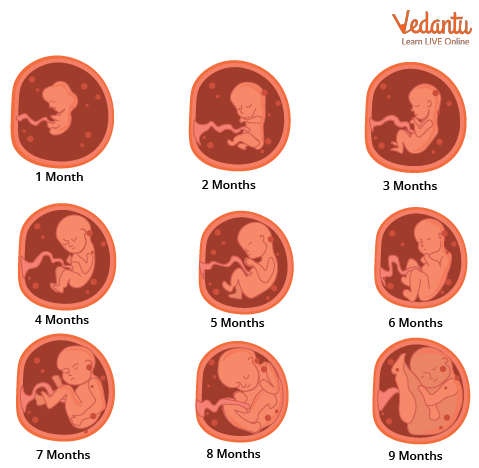
Gestation
What is Gestation?
Gestation, commonly called pregnancy, is the period of full development of a baby inside the mother’s womb. It involves the physical, mental, and overall nourishment of the baby before it is ready for birth into the world.
Duration of Human Gestation
Humans are relatively complex species. As mentioned earlier we’re made of trillions of cells. Can you roughly guess how long it will take for the formation of a trillion cells from just two cells? The answer to that question is roughly 40 weeks which is around 9-10 months. So, when a little human is kicking in the womb it actually takes at least 9 months before they are out and about in the real world.
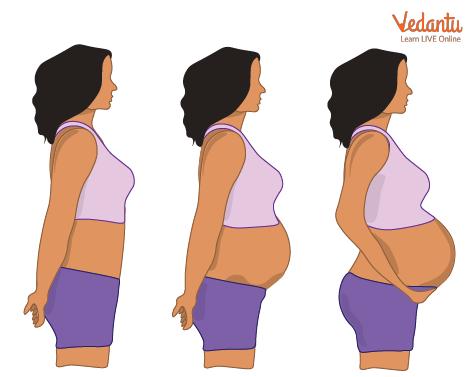
Pregnancy
In this crucial period, the baby grows in size, develops its fundamental organs, and starts kicking (for real!) There are several changes that take place in the mother’s body to accommodate the growing baby, the most important of which is the growth of the womb to give space for the baby which is seen as the baby bump as shown above.
Stages of Gestation
In humans, the 9 months of gestation are divided into 3 trimesters ( trimester meaning 3 months; tri-3) which gives us three separate phases to deal with in detail.
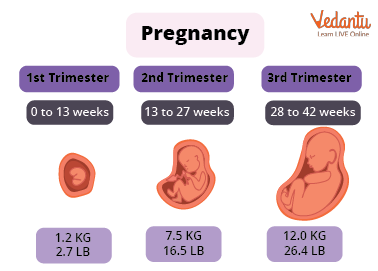
Trimesters
The First Trimester
Once the baby is nice and snuggly placed in the womb (At this stage called the embryo) it starts to exhibit fast and vital signs of growth.
These can be seen as follows:
The neural tube develops closing the brain and spinal cord
Development of heartbeat
Formation of ears and eyes
Development of hands and toe
Development of genital parts
Placement of intestines in the abdominal region
It is an interesting factor to note that the baby is just weighing 14 grams and is around 2.5 inches in length at the end of the first trimester (9-12 weeks) now called a foetus (another fancy-sounding name for a small baby) is roughly the size of a plum!
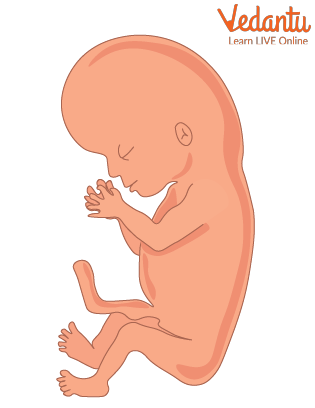
Embryo
The Second Trimester
Now that the foetus looks more like a human baby, further growth and maturation take place in the second trimester (13-27 weeks).
The baby which was earlier just a bunch of cells now starts to look more human-like with mature features
Urine excretion into the surrounding amniotic fluid sac
The umbilical cord is connected to the placenta
Thickening of bones
Nails begin to develop
Hair becomes visible
Baby can hear and it responds to voice and sudden movements
Lungs develop
The baby is around 820 g in weight and 9inches in length. At the end of the 27th week, the baby is the size of a cauliflower!

Foetus
The Third Trimester
The final trimester bringing this heroic journey sure ends with a bang. The third trimester (28-40 weeks) completes the period of gestation at the end of which the baby is ready to come to this world. Some of the notable changes in this trimester include:
Baby starts kicking and stretching
Rapid weight gain
The baby is sensitive to light
The chest becomes more prominent
Head turns down ( for easier birth for the mother)
The baby weighs approximately 3400 grams and is around 14 inches in length. At the end of gestation, the baby is the size of a jackfruit!
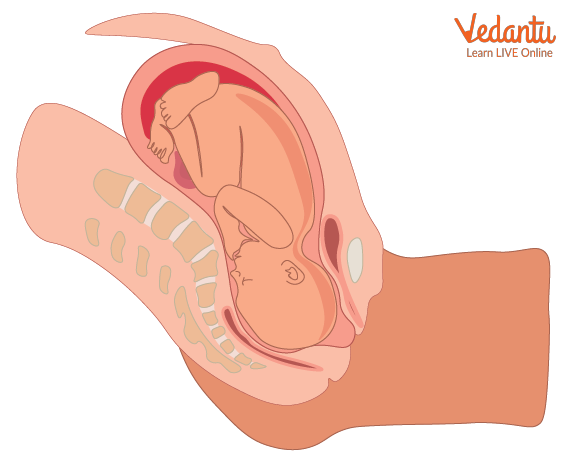
Full Growth of Baby
Summary
Gestation is the process of development and maturation of a human baby in the mother’s womb for a period of around 40 weeks.
Also known as pregnancy, gestation is divided into 3 trimesters each having distinctive developmental phases for the baby.
Initially clusters of cells, the baby slowly develops through various stages from the size of poppy seeds to plums to cauliflower and finally to that of a jackfruit.
At the end of 40 weeks, the baby is ready for birth and is brought out by a process called ‘parturition’ (also known as childbirth).
FAQs on Gestation Period in Humans
1. Do all organisms undergo a period of gestation before birth?
Yes, all complex mammals (organisms that give birth to young ones) have periods of gestation before giving birth.
This period is important for the formation of vital organs and the maturation of structures before birth.
Mammals have a similar pattern when it comes to gestational development in the young ones however some differences can be appreciated from one organism to another.
2. Does the period of gestation vary from organism to organism?
Indeed, the duration of the gestation period varies depending on the size and structural organisation of the organism.
A relatively smaller organism with simple body organisation like a squirrel requires very less period of gestation, around 6 weeks.
On the other hand, a much more complex organism with a structured body organisation like an elephant required a longer gestation to fully mature and be ready for birth, around 22 months.
3. Are all gestations exactly 40 weeks?
Nope, the duration of gestation depends on the mother as well as the conditions of the baby. Some gestations terminate before 40 weeks leading to the birth of a premature baby.
However, it is kind of important that the gestation lasts for a maximum of 40 weeks (38-42 weeks is normal) for the birth of a healthy baby.









